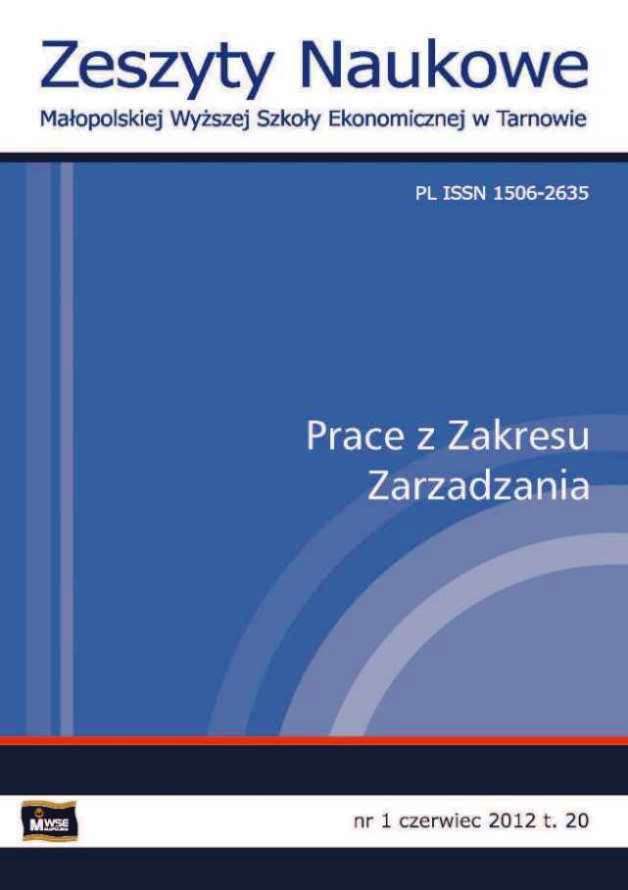Abstract
The aim of the paper is to assess diversification dynamics of the agrarian structure of voivodeships in years 1996-2008. The calculations were made on the basis of statistical data obtained from the Central Statistical Office—the number and area of farms have been grouped by voivodeships. With the use of a fuzzy classification method, voivodeships have been divided into groups of similar agrarian structures according to data of 1996, 2002 and 2008. As a result, 4 groups comprising the same voivodeships in each year have been distinguished. Group I con- sists of Małopolskie, Śląskie and Podkarpackie voivodeships. It is characterized by the highest degree of fragmentation of the agrarian structure. In 2008 around 82% of farms had the area of 1-5 hectares, while 14.4% of them had the area of 5-10 hectares. The remaining farms repre- sent a very small proportion: 10-20 hectares—3.3%, 20-50 hectares—1.1%, more than 50 hectares—0.3%. Group II consists of Łódzkie, Mazowieckie and Lubelskie voivodeships, where structure indices are as follows: 51.5%, 29.2%, 14%, 4.2% and 0.5%. The lowest degree of fragmentation is observed in group III, comprising Podlaskie, Kujawsko-Pomorskie, Pomorskie, Warmińsko-Mazurskie and Wielkopolskie voivodeships. The average structure is more regular in this group: 35.5%, 23%, 25.2%, 13.3% and 3.1%. Group IV consists of Lubuskie, Dolnośląskie and Opolskie voivodeships and average structure indices are as follows: 57%, 19.9%, 12.5%, 7.3% and 3.2%.
References
Bogocz D., Bożek J., Kukuła K., Strojny J., Statystyczne studium struktury agrarnej w Polsce, Wyd. Naukowe PWN, Warszawa 2010. ISBN 978-83-01-15950-4.
View in Google Scholar
Bożek J., Dynamika i perspektywy przyrostu liczby dużych gospodarstw rolnych w Polsce, „Roczniki Naukowe Stowarzyszenia Ekonomistów Rolnictwa i Agrobiznesu” 2009, t. 11, z. 1, s. 43-47.
View in Google Scholar
Dzun W., Gospodarstwa rolne w procesie transformacji systemowej (1990-2002), „Wieś i Rolnictwo” 2004, nr 1.
View in Google Scholar
Jajuga K., Zbiory rozmyte w zagadnieniu klasyfikacji, „Przegląd Statystyczny” 1984, z. 3/4, s. 237-290.
View in Google Scholar
Mieszczankowski M., Rolnictwo II Rzeczypospolitej, Książka i Wiedza, Warszawa 1983.
View in Google Scholar
Nietupski T., Zmiany w strukturze obszarowej gospodarstw wobec wejścia Polski do Unii Europejskiej. W: E. Otoliński (red.), Przemiany w organizacji gospodarstw - nowe wyzwania w aspekcie integracji Polski z Unią Europejską, Zeszyty Naukowe Akademii Rolniczej im. H. Kołłątaja w Krakowie, Kraków 1998, z. 55, s. 51-64.
View in Google Scholar
Sikorska A., Przemiany w strukturze agrarnej gospodarstw chłopskich, IERiG-PIB, Warszawa 2006.
View in Google Scholar
Wawrzyniak B., Kierunki ewolucji struktury agrarnej w Polsce w świetle spisów rolnych z 1996 i 2002 r., „Acta Scientiarum Polonorum. Oeconomia” 2004, nr 3(1), s. 125-134.
View in Google Scholar
Woś A., Przekształcenia strukturalne rolnictwa w dobie integracji europejskiej, „Zagadnienia Ekonomiki Rolnej” 2003, nr 4.
View in Google Scholar
Zadeh L.A., Fuzzy Sets, „Information and Control” 1965, no. 8, s. 338-353.
View in Google Scholar
© Copyright by Małopolska School of Economics in Tarnów. The articles are available under the Creative Commons Attribution NonCommercial-NoDerivatives 4.0 International License


